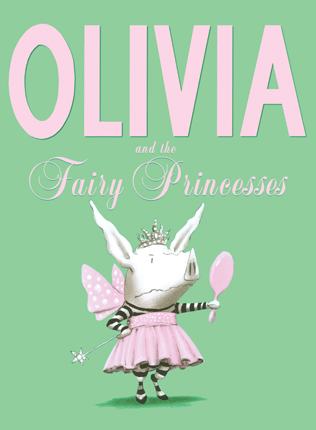| Olivia and the fairy princesses (Olivia) Author: Falconer, Ian | ||
| Price: $24.48 | ||
Summary:
Olivia is having an identity crisis! There are too many ruffly, sparkly princesses around these days, & she has had quite enough. She needs to stand out!![]() Download a Teacher's Guide
Download a Teacher's Guide
| Accelerated Reader Information: Interest Level: LG Reading Level: 2.90 Points: .5 Quiz: 153270 | Reading Counts Information: Interest Level: K-2 Reading Level: 2.50 Points: 1.0 Quiz: 57582 | |
Reviews:
Kirkus Reviews (07/01/12)
School Library Journal (08/01/12)
Booklist (08/01/12)
The Bulletin of the Center for Children's Books (09/12)
Full Text Reviews:
School Library Journal - 08/01/2012 PreS-Gr 2—Olivia is back and as strong-willed as ever in this rumination on individuality. The usually upbeat piglet is depressed. "I think I'm having an identity crisis." All of the children in her class want to be princesses. In pink, "...even some of the boys." But Olivia likes to be unique. "Why not an Indian princess…or an African princess…."? For the ballet recital, everyone wants to be the fairy princess. But Olivia is "trying to develop a more stark, modern style." The hilarious attempt results in a series of spot illustrations of Olivia in a dark tube dress, posing in different positions, à la Martha Graham. For Halloween, she is a warthog. And she has had enough of fairy tales with princesses. At last, she realizes what she wants to be: Queen, of course! Falconer's trademark use of minimalistic color to make Olivia stand out from the crowd is in full force here. His visual humor underscores his punch lines and illustrates Olivia's imagination. Showcasing words like "treatments" and "corporate malfeasance," the text will occasionally go over youngsters' heads, and the subtle, sophisticated humor is pitched at adults as well as children. Falconer's witty parent-child banter will resonate with listeners old and young alike. Anyone who is afraid of challenging words and complex ideas should stay away, but parents looking for a way to expand their children's minds with more than a few chuckles along the way will find this story just the ticket. More please.—Amy Lilien-Harper, The Ferguson Library, Stamford, CT - Copyright 2012 Publishers Weekly, Library Journal and/or School Library Journal used with permission.
Booklist - 08/01/2012 Olivia is depressed. She sees that individuality counts for little in her world. Every other piggy girl (and some of the boys) all like to dress as sparkling fairy princesses. She, however, prefers a French sailor shirt, matador pants, red bag, pearls, and a gardening hat. Wherever she turns—ballets, books, bedtime stories—there are princesses. After she spends the night pondering what she can be other than a princess, the last page shows her glorious answer. She has made the leap—to queen. The text has some funny moments—when Olivia disdains a happily-ever-after story, her mother switches to “The Little Match Girl”—but as with previous books, most of the fun comes from the delicious artwork executed in signature charcoal perked up with reds. Here the high points include Olivia as four different kinds of costumed princess (Thai, African, Indian, and Chinese); a two-page spread of dancer Olivia eschewing tutus, dressed as Martha Graham in Lamentation; and Queen Olivia at the balcony. There are also some strong messages here about individuality and reinventing yourself according to your own vision. It’s an idea you’re never to young to learn. HIGH-DEMAND BACKSTORY: Olivia is a successful franchise now, but quality remains high. Fans will be pleased with this addition to the series. - Copyright 2012 Booklist.
Bulletin for the Center... - 09/02/2012 Olivia can’t understand it—why do all the other little girls want to dress up like princesses all the time? When her mother reminds Olivia that just last year she, too, wanted to be a princess ballerina for Halloween, Olivia counters that “that was when I was little. I’m trying to develop a more stark, modern style,” as Falconer depicts her dressed in a stretchy charcoal tube, trying out multiple poses à la Martha Graham’s Lamentation. Even bedtime stories remind Olivia of the popularity of princesses, and as sleep eludes her she tries to imagine alternate future occupations, such as nurse (“I could use my brothers to practice bandaging. And various other treatments,” she muses while imagining herself holding a hypodermic needle as her near-mummified brothers look on). Finally, in typical Olivia style, she decides to go straight to the top of the power chain: “I want to be queen.” While the plot is a bit loose, independent-minded Olivia continues to be an endearing and distinctive heroine, and many a kid (and adult) weary of Barbie-pink fluff will find Olivia’s perspective refreshing. The pastel mint and ballerina-pink cover design may appeal to the very sensibilities Olivia is eschewing, and the hordes of piglets clad in rosy tutus are actually quite adorable, but confident Olivia pictorially makes a strong case for striped ensembles and primary hues as she attractively poses in Falconer’s charcoal and gouache illustrations. This is a helpful reassurance that there are enjoyable alternatives to pink princesses for imaginative play and dressup possibilities. JH - Copyright 2012 The Board of Trustees of the University of Illinois.



